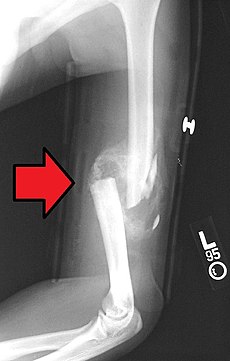Humerus fracture
| Humerus fracture | |
|---|---|
| Classification and external resources | |

Comminuted midshaft humerus fracture with callus formation
|
|
| ICD-10 | S42.2-S42.4 |
| AO | 11A1-13C3 |
| eMedicine | 1239985, 1261320 |
| MeSH | 68006810 |
A humerus fracture is a bone fracture of the bone of the upper arm, the humerus. Fractures of the humerus may be classified by the location of the fracture and divided into fractures of the proximal region, which is near the shoulder, the middle region, which is the shaft of the humerus, and the distal region, which is near the elbow. These locations can further be divided based on the extent of the fracture and the specific areas of each of the three regions affected. Humerus fractures usually occur after physical trauma, falls, excess physical stress, or pathological conditions. Falls are the most common cause of proximal and shaft fractures, and those who experience a fracture from a fall usually have an underlying risk factor for bone fracture. Distal fractures occur most frequently in children who experience physical trauma to the elbow area.
Symptoms of fracture are pain, swelling, and discoloration of the skin at the site of the fracture. Bruising appears a few days after the fracture. The neurovascular bundle of the arm may be affected in severe cases, which will cause loss of nerve function and diminished blood supply beneath the fracture. Proximal and distal fractures will often cause a loss of shoulder or elbow function. Displaced shaft and distal fractures may cause deformity, and such shaft fractures will often shorten the length of the upper arm. Most humerus fractures are nondisplaced and will heal within a few weeks if the arm is immobilized. Severe displaced humerus fractures and complications often require surgical intervention. In most cases, normal function to the arm returns after the fracture is healed. In severe cases, however, function of the arm may be diminished after recovery.
Fractures of the humerus are classified based on the location of the fracture and then by the type of fracture. There are three locations that humerus fractures occur: at the proximal location, which is the top of the humerus near the shoulder, in the middle, which is at the shaft of the humerus, and the distal location, which is the bottom of the humerus near the elbow. Proximal fractures are classified into one of four types of fractures based on the displacement of the greater tubercle, the lesser tubercle, the surgical neck, and the anatomical neck, which are the four parts of the proximal humerus, with fracture displacement being defined as at least one centimeter of separation or an angulation greater than 45 degrees. One-part fractures involve no displacement of any parts of the humerus, two-part fractures have one part displaced relative to the other three; three-part fractures have two displaced fragments, and four-part fractures have all fragments displaced from each other. Fractures of the humerus shaft are subdivided into transverse fractures, spiral fractures, "butterfly" fractures, which are a combination of transverse and spiral fractures, and pathological fractures, which are fractures caused by medical conditions. Distal fractures are split between supracondylar fractures, which are transverse fractures above the two condyles at the bottom of the humerus, and intercondylar fractures, which involve a T- or Y-shaped fracture that splits the condyles.
...
Wikipedia
